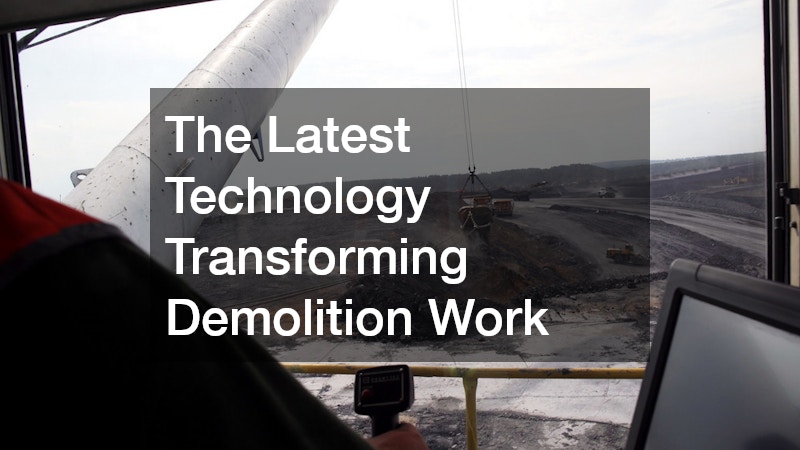Demolition is a critical part of construction and urban development. Whether it’s clearing old buildings for new projects or removing unsafe structures, demolition work requires precision, safety and efficiency.
Recent advancements in technology have transformed how demolition is carried out, making it faster, safer and more environmentally friendly.
Understanding these new technologies helps homeowners, builders and industry professionals appreciate the benefits and potential of modern demolition methods.
Robotics and Automated Equipment
One of the biggest shifts in demolition is the use of robotics and automated machinery. Remote-controlled demolition robots are now common on many sites. These machines can reach areas that would be dangerous or difficult for human workers, such as confined spaces or unstable structures.
Robots equipped with hydraulic arms, crushers and drills allow for precise dismantling while reducing the risk of injury. They also help reduce the need for manual labour, which speeds up the demolition process and cuts costs.
Automation is also being used in heavy machinery such as excavators and bulldozers. GPS and computer-guided controls enable operators to work with greater accuracy, reducing damage to surrounding properties and minimising waste.
Advanced Recycling and Waste Management Technologies
Sustainability is a growing concern in the demolition industry. New technologies focus on improving the recovery and recycling of materials from demolition sites. Sorting systems use sensors and AI to separate concrete, metal, timber and other materials efficiently.
Recycling concrete into aggregate for road base or new concrete reduces landfill waste and lowers the demand for virgin materials. Metal salvaged from demolition is often melted down and reused, helping conserve natural resources.
These technologies also help demolition companies comply with stricter environmental regulations and support circular economy principles.
Dust Suppression and Air Quality Monitoring
Dust is a major challenge in demolition work, impacting both workers and nearby communities. Modern demolition sites employ sophisticated dust suppression technologies, such as high-pressure water sprays and misting systems that control airborne particles.
Air quality monitoring devices are also increasingly common. They provide real-time data on dust and pollutant levels, allowing supervisors to adjust suppression efforts immediately.
These measures not only protect health and safety but also improve community relations by minimising nuisance and potential legal issues related to air pollution.
Drones for Site Inspection and Monitoring
Drones have become invaluable tools in demolition. They provide aerial views of sites, helping teams plan work with better insight into building structure and site layout. This reduces guesswork and unexpected issues during demolition.
Drones can safely inspect hazardous or hard-to-reach areas, such as roofs or tall buildings, without putting workers at risk. They also allow for regular monitoring and progress updates, improving communication between contractors and clients.
Data collected by drones can be processed using 3D modelling software, which further enhances project planning and management.
Cutting-Edge Safety Equipment
Safety is paramount in demolition, and technology plays a key role in improving it. Wearable tech, such as smart helmets and vests, can monitor workers’ vital signs and environmental conditions. These devices alert supervisors if someone is at risk of heat stress, fatigue or exposure to harmful gases.
Proximity sensors and geofencing technology prevent workers and machinery from entering dangerous zones. Automated shutdowns can be triggered if hazards are detected, reducing accidents.
Virtual reality (VR) training is also being used to prepare demolition crews for complex or risky tasks. This immersive learning environment improves skills without exposing workers to real danger.
Innovative Demolition Techniques
Traditional demolition methods often involved wrecking balls or explosive charges, but newer techniques are more controlled and precise. Hydraulic shears, crushers and pulverisers attached to excavators allow for selective demolition, where parts of a structure can be removed while preserving others.
Cutting-edge methods like wire sawing use diamond-tipped blades to slice through concrete and steel with minimal vibration and noise. This is especially useful in urban areas where disruption must be kept to a minimum.
These innovations reduce the environmental impact of demolition and speed up site clearance, enabling faster construction turnaround times.
Benefits for Builders and Property Owners
For builders and property owners, these technological advances mean less downtime and reduced costs. Faster, more accurate demolition helps projects stay on schedule and within budget.
Improved safety protocols protect workers and reduce liability risks. Enhanced recycling and waste management lower disposal fees and contribute to sustainable building practices.
Moreover, community impact is minimised through dust control, noise reduction and careful site monitoring. This can improve relations with neighbours and local authorities, making approvals and permits easier to obtain.
The Future of Demolition
Technology will continue to shape the demolition industry. Emerging trends include greater integration of artificial intelligence for automated decision-making and predictive maintenance of machinery.
Green demolition techniques that prioritise material reuse and energy efficiency are also gaining traction. As cities grow and older buildings require replacement, sustainable demolition practices will be increasingly important.
Staying informed about these changes helps stakeholders make better choices and contribute to a safer, cleaner and more efficient construction industry.

